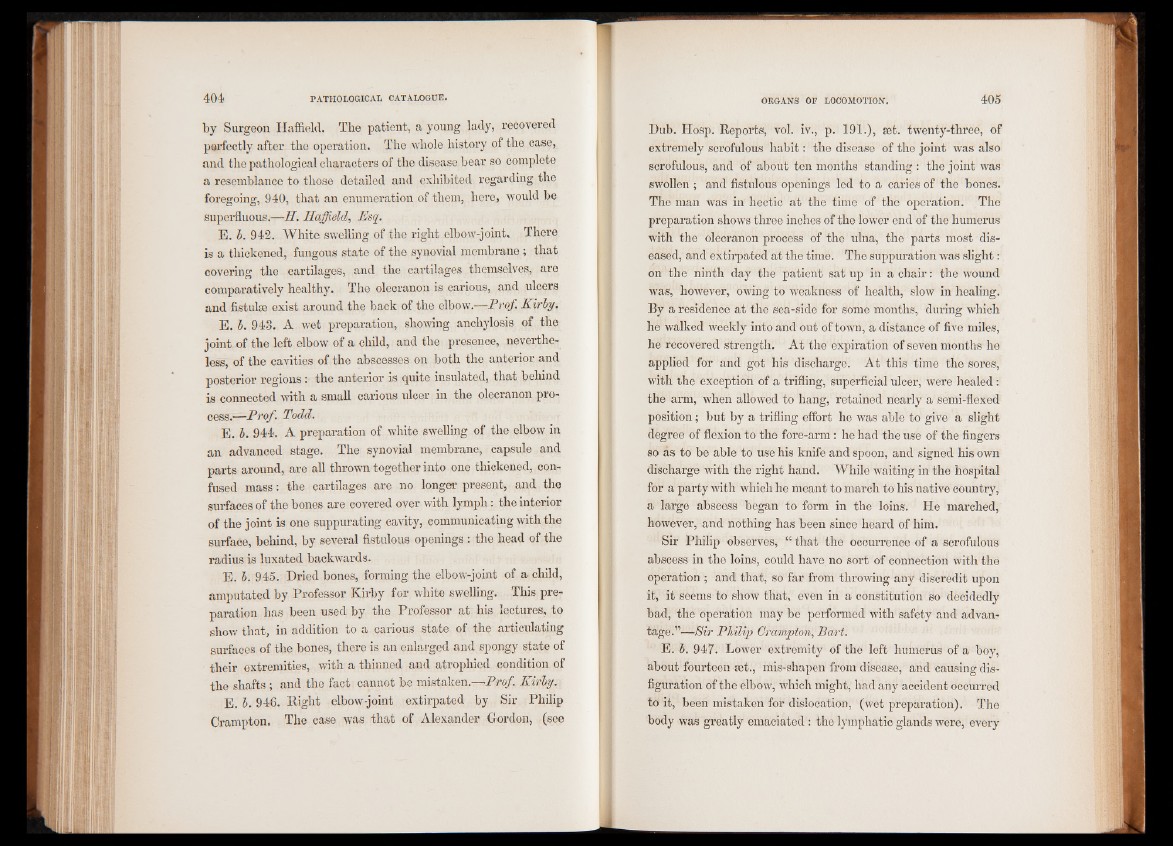
by Surgeon Haffield. The patient, a young lady, recovered
perfectly after the operation. The whole history of the case,
and the pathological characters of the disease bear so complete
a resemblance to those detailed and exhibited regarding the
foregoing, 940, that an enumeration of them, here, would be
superfluous.—H. Haffield, Esq.
E. b. 942. White swelling of the right elbow-joint. There
is a thickened, fungous state of the synovial membrane ; that
covering the cartilages, and the cartilages themselves, are
comparatively healthy. The olecranon is carious, and ulcers
and fistulse exist around the back of the elbow.—Prof. Kirby.
E. b. 943. A wet preparation, showing anchylosis of the
joint of the left elbow of a child, and the presence, nevertheless,
of the cavities of the abscesses on both the anterior and
posterior regions: the anterior is quite insulated, that behind
is connected with a small carious ulcer in the olecranon process^—
Prof. Todd.
E. b. 944. A preparation of white swelling of the elbow in
an advanced stage. The synovial membrane, capsule and
parts around, are all thrown together into one thickened, confused
mass: the cartilages are no longer present, and the
surfaces of the bones are covered over with lymph: the interior
of the joint is one suppurating cavity, communicating with the
surface, behind, by several fistulous openings : the head of the
radius is luxated backwards.
E. b. 945. Dried bones, forming the elbow-joint of a child,
amputated by Professor Kirby for white swelling. This preparation
has been used by the Professor at his lectures, to
show that, in addition to a carious state of the articulating
surfaces of the bones, there is an enlarged and spongy state of
their extremities, with a thinned and atrophied condition of
the shafts; and the fact cannot be mistaken.—Prof. Kirby.
E. b. 946. Right elbow-joint extirpated by Sir Philip
Crampton. The case was that of Alexander Gordon, (see
Dub. Hosp. Reports, vol. iv., p. 191.), set. twenty-three, of
extremely scrofulous habit: the disease of the joint was also
scrofulous, and of about ten months standing : the joint was
swollen ; and fistulous openings led to a caries of the bones.
The man was in hectic at the time of the operation. The
preparation shows three inches of the lower end of the humerus
with the olecranon process of the ulna, the parts most diseased,
and extirpated at the time. The suppuration was slight:
on the ninth day the patient sat up in a chair: the wound
was, however, owing to weakness of health, slow in healing.
By a residence at the sea-side for some months, during which
he walked weekly into and out of town, a distance of five miles,
he recovered strength. At the expiration of seven months he
applied for and got his discharge. At this time the sores,
with the exception of a trifling, superficial ulcer, were healed:
the arm, when allowed to hang, retained nearly a semi-flexed
position; but by a trifling effort he was able to give a slight
degree of flexion to the fore-arm: he had the use of the fingers
so as to be able to use his knife and spoon, and signed his own
discharge with the right hand. While waiting in the hospital
for a party with which he meant to march to his native country,
a large abscess began to form in the loins. He marched,
however, and nothing has been since heard of him.
Sir Philip observes, “ that the occurrence of a scrofulous
abscess in the loins, could have no sort of connection with the
operation ; and that, so far from throwing any discredit upon
it, it seems to show that, even in a constitution so decidedly
bad, the operation may be performed with safety and advantage.”—
Sir Philip Crampton, Bart.
E. b. 947. Lower extremity of the left humerus of a boy,
about fourteen set., mis-shapen from disease, and causing disfiguration
of the elbow, which might, had any accident occurred
to it, been mistaken for dislocation, (wet preparation). The
body was greatly emaciated : the lymphatic glands were, every